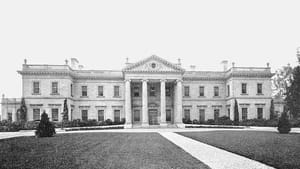Stay in the Loop
BSR publishes on a weekly schedule, with an email newsletter every Wednesday and Thursday morning. There’s no paywall, and subscribing is always free.
Philly secretly comes to the rescue
The Met II in World War II

Thanks to The Monuments Men, the wartime Met is now best known for its one-time director James J. Rorimer, a principal in organizing the group of GIs who, in their role in hunting down Europe's art treasures stolen by the Nazis, became known in romantic vernacular as the "Monuments Men."
Less known is how another Met director, Francis Henry Taylor, Rorimer's predecessor and a former curator at the Philadelphia Museum of Art, worked quietly during the early war years to protect America's art patrimony. Thanks to Taylor, a mansion in Springfield, Montgomery County became an auxiliary venue of the venerable New York art institution. In secret.
Whitemarsh Hall, the former mansion and 300-acre estate of a fabulously wealthy Philadelphia banker, became the Met's wartime repository. The mansion was demolished in 1980 to make way for a mid-market housing development. Part of that development, including the estate's entrance gates, a gatehouse, and other fragments and statuary, preserve the name of Edward T. Stotesbury, the Drexel banker who commissioned the renowned Philadelphia architect Horace Trumbauer to build the place in 1921. Stotesbury died in 1938.
Today, the skeletal scene — an incongruous architectural array of the old and exotic and the new and ordinary — is simply eerie. But even 70 years ago, to the casual observer, Whitemarsh Hall might have seemed as an unlikely setting for an off-site museum.
The American Versailles
In its day, the big house was flush with servants and opulent French antiques and artwork, installed by the great English art dealer, Lord Joseph Duveen. The mansion was also surrounded by gardens that were reminiscent of those designed by Louis XIV's landscaper André Le Nôtre. It was no surprise, then, that Whitemarsh Hall got to be known, despite its neo-Georgian design, by the cheeky sobriquet "the American Versailles."
In 1942, Taylor was looking at a stripped-down version of the palatial homestead, which had become the victim of the Stoteburys' financial reversals during the Depression. What remained of the interior — 147 rooms on six floors (three underground), with 100,000 square feet of floor space — was almost like, in Taylor's view, a purpose-built museum. The existing mansion was fireproof (built in steel and concrete) and featured air conditioning, humidity controls, and its own electrical system and water supply.
It was, in other words, almost a ready-made Met II.
An overreaction?
For many today,protecting the museum's collection in a off-site location might seem like an overreaction to a questionable threat. Could the German Luftwaffe really bomb New York? Would German commandos, landing by U-boat, attack cultural institutions?
Those threats, in historical hindsight today, appear remote, at best. But in the wake of the devastation at Pearl Harbor — the Japanese bombed a target thousands of miles away from their homeland, after all — New Yorkers weren't taking any chances.
And there was some real cause for concern. U-boats were destroying shipping off the East Coast. At least one air raid was sounded over the city, scrambling 280 fighter planes. (It was a false alarm.) And though mostly boastful bombast, some people were not fully dismissing threats by the Luftwaffe's head, Hermann Goering, to drop five-ton bombs on New York to "stop somewhat the mouths of arrogant people over there."
Taylor's first idea was to remove the artwork to a former water main tunnel under the museum's Fifth Avenue site.
That plan was quickly rejected when it was determined that lingering moisture in the tunnel would be too harmful.
Instead, in January 1942, just a month after Pearl Harbor, the Met announced that it had removed most of its major treasures to a country home "a hundred miles inland."
Carefully considered
The concept wasn't original. The British, mired in the war since 1939, had safeguarded many of the irreplaceable contents of the British Museum and other arts institutions in abandoned Underground stations in London and at country houses in Wales.
The Met's transfer, under a two-year lease, wasn't haphazard. In short order, about 15,000 to 20,000 priceless pieces, including mummies, tapestries, and about 500 paintings, were ensconced at Whitemarsh Hall.
Like all wartime secrets, Met II's whereabouts was shared on a need-to-know basis. But how hush-hush the move really was is open to debate. In fact, Met II expanded to include collections from the Brooklyn Museum, Cooper Union in New York, and the American Philosophical Society in Philadelphia. Even some private collectors got into the act.
By the time Whitemarsh Hall was full up and the Nazis were on the run in 1944, one wag in the New York museum world was referring to Met II as no longer the "American Versailles" but as a "monument hystérique."
Photo above right courtesy of the author.
Sign up for our newsletter
All of the week's new articles, all in one place. Sign up for the free weekly BSR newsletters, and don't miss a conversation.
 Richard Carreño
Richard Carreño